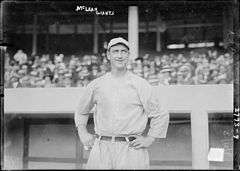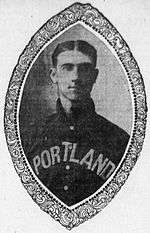Larry McLean
John Bannerman McLean (July 18, 1881 – March 24, 1921) was a professional baseball catcher between 1901 until 1915. During his years in Major League Baseball, he played for five different teams. Beginning his career with the Boston Americans, his final professional game was played with the New York Giants on June 6, 1915.
| Larry McLean | |||
|---|---|---|---|
 McLean with the New York Giants in 1913 | |||
| Catcher | |||
| Born: July 18, 1881 Fredericton, New Brunswick | |||
| Died: March 24, 1921 (aged 39) Boston, Massachusetts | |||
| |||
| MLB debut | |||
| April 26, 1901, for the Boston Americans | |||
| Last MLB appearance | |||
| June 6, 1915, for the New York Giants | |||
| MLB statistics | |||
| Batting average | .262 | ||
| Home runs | 6 | ||
| Runs batted in | 298 | ||
| Teams | |||
| |||
McLean was one of the tallest catchers in major league history. Known for his heavy drinking and violent behavior, McLean's career ended after a 1915 brawl with New York Giants manager John McGraw and coach Dick Kinsella. He was fatally shot by a bartender six years after his last major league appearance.
Early life
McLean was born in Fredericton, New Brunswick. He earned the nickname Larry after the alternate moniker ascribed to Nap Lajoie, a star baseball player who McLean was said to resemble.[1] In 1901, while McLean and Fred Mitchell were playing for a local team in Saint John, New Brunswick, they were scouted and signed by the fledgling Boston Red Sox.[2]
Playing career
On December 12, 1903, McLean was traded from the Cubs to the Cardinals in what has been described as "one of the worst trades in Cardinals history."[3] McLean and Jack Taylor were traded to the Cardinals in exchange for future Baseball Hall of Fame member Three Finger Brown and Jack O'Neill.[3]
McLean was known to chew large amounts of Brown's Mule tobacco and was a heavy drinker of corn whiskey. When he signed with the Portland Beavers of the Pacific Coast League in 1905, he became teammates with a pitcher who also struggled with alcohol use, Ned Garvin. Baseball author Dennis Snelling said that this pitcher-catcher combination formed "one of the most volatile batteries in the history of the game."[4]

In 1906, McLean signed with Portland again for a $1400 annual salary. McLean's wife publicly voiced her objection to the salary, and she said that Portland owner William Wallace McCredie was not paying McLean consistent with his value. She said that the minor-league team in Altoona was willing to sign him for $2400 per year.[5] McLean did play in 88 games for the 1906 Portland Beavers and he hit .355. The team won the Pacific Coast League; the second-place team was 21 games out of first place.[6] A drinking incident with Cincinnati that year ended with McLean jumping in the fountain at the Buckingham Hotel, and it resulted in McLean being demoted back to the minor leagues by manager Kid Nichols. "I can pitch to Larry real good, but I can't manage him worth a dime," Nichols said.[7]
Before the 1910 season, the Reds suspended McLean after he violated team rules during spring training at Hot Springs, Arkansas. In response to the suspension, McLean wrote a "letter of resignation" from the club. His resignation was accepted, but he was later allowed to rejoin the team with the caveats that he would play for a reduced salary and would sit out the first week of the regular season.[8]
In August 1913, McLean was traded from the St. Louis Cardinals to the New York Giants in exchange for Doc Crandall. Chief Meyers was the Giants' primary catcher, but he was injured during the 1913 postseason, so McLean played five games in the 1913 World Series. McLean was the first player born in New Brunswick to appear in a World Series.[9]
Career-ending fight
In June 1915, McLean engaged in a brawl with Giants manager John McGraw and scout Dick Kinsella. McLean had recently been suspended for ten days for failing to stay in shape. He was angry at Kinsella because he felt the scout had convinced McGraw to suspend him. McLean and several companions entered the lobby of the team's hotel and attacked Kinsella. The melee escalated and Kinsella broke a chair over McLean's head while several team members worked to subdue McLean. The catcher and his companions fled in a car.[10]
McGraw dismissed McLean from the Giants later that day.[10] McLean's playing time had been in decline since 1913. Despite McLean's attempts to regain his place on the team, Chief Meyers fully took over the team's catching responsibilities after McLean's dismissal and McLean did not appear in another major league game.
In his thirteen-year career, McLean posted a .262 batting average, which included six home runs and 298 RBIs in 862 games played.[11]
Death
McLean was killed on March 24, 1921 in Boston, where he was shot by the manager of a saloon. He had become unruly the night before his death and chased a bartender out of the saloon. When McLean returned on the night of March 24, he became offended when the manager refused to give him a cigarette. The manager said that McLean was attempting to crawl over the bar, aided by his friend Jack McCarthy, when the manager fired a gunshot.[12]
McLean was dead when he arrived at the hospital, while McCarthy was hospitalized with a gunshot wound to the stomach. The saloon manager, James J. Connor, was arrested on suspicion of murder.[12]
Legacy
McLean received one vote in the 1937 Baseball Hall of Fame elections. He was inducted into the New Brunswick Sports Hall of Fame in 2000 and the Canadian Baseball Hall of Fame in 2006.[9][13] At 6 ft 5 in (1.96 m), McLean long held the record as being the tallest catcher in major league history.[14]
References
- Russo, Frank; Racz, Gene (2006). Bury My Heart at Cooperstown: Salacious, Sad, and Surreal Deaths in the History of Baseball. Chicago: Triumph Books. ISBN 1617499366. Retrieved March 25, 2016.
- Nowlin, Bill, ed. (2014). The Miracle Braves of 1914: Boston's Original Worst-to-First World Series Champions. Society for American Baseball Research. p. 193. ISBN 1933599707. Retrieved 25 March 2016.
- Snyder, John (2011). 365 Oddball Days in St. Louis Cardinals History. Clerisy Press. ISBN 1578604729. Retrieved March 25, 2016.
- Snelling, Dennis (2012). The Greatest Minor League: A History of the Pacific Coast League, 1903-1957. Jefferson, N.C.: McFarland & Co. p. 28. ISBN 0786488034. Retrieved March 25, 2016.
- "Mrs. M'Lean is not pleased". The Sacramento Union. March 4, 1906. Retrieved March 25, 2016.
- "Top 100 Teams: 31. 1906 Portland Beavers". MiLB.com. Retrieved March 25, 2016.
- Gmelch, George (2006). Baseball Without Borders: The International Pastime. University of Nebraska Press. p. 215. ISBN 080325606X. Retrieved March 25, 2016.
- "Punishment for Larry M'Lean". Chicago Daily Tribune. April 10, 1910. Retrieved March 25, 2016.
- "Sports pioneers named to Hall of Fame (00/02/17)". New Brunswick Sports Hall of Fame. February 17, 2000. Retrieved March 25, 2016.
- McLean on a rampage; attacks scout Kinsella and McGraw banishes him from Giants. The New York Times. June 12, 1915. Retrieved October 29, 2012.
- "Larry McLean Statistics and History". Baseball-Reference.com. Retrieved October 1, 2009.
- Former big league catcher Larry McLean, shot and killed. The Toronto World. March 25, 1921. Retrieved March 25, 2016.
- "Lasorda to be inducted to Canadian Baseball Hall of Fame". Baseball Canada. Retrieved March 25, 2016.
- Smith, Bryan (June 27, 2006). "Gazing Through Binoculars". The Baseball Analysts. Retrieved October 1, 2009.
Sources
- Career statistics and player information from Baseball-Reference
- Larry McLean at Find a Grave
